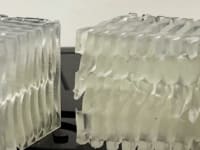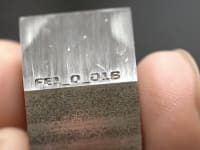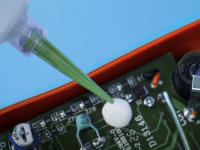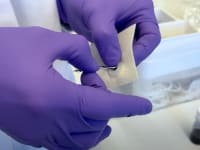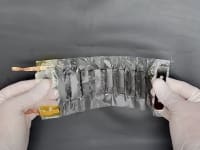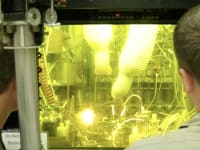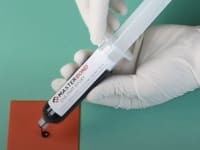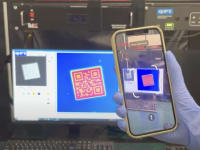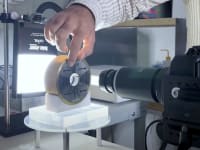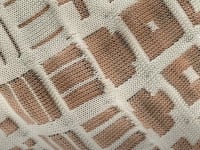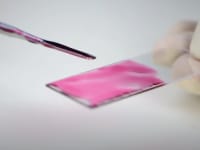38
61
169
-1
1290
30
Briefs: Materials
Application of Carbon Nanotube Hold-Off Voltage for Determining Gas Composition
In this innovation, a method and associated system have been created to vary a voltage applied to an exposed end of a carbon nanotube for a selected time interval to promote gas discharge, and to estimate a gas component involved in the discharge. Each component of a...
Briefs: Energy
Solar-Powered Carbon Dioxide Conversions with Thin-Film Devices
A nanomaterial thin-film device provides a low-cost, facile fabrication pathway to commercialize the technology to the sustainable energy market. Metal oxide thin films have been fabricated to a photoelectrochemical cell by solar energy. The prototype device uses both low energy cost...
Briefs: Materials
Regenerable Trace-Contaminant Sorbent for the Primary Life Support System (PLSS)
The NASA objective of expanding the human experience into the far reaches of space requires the development of regenerable life support systems. This work addresses the development of a regenerable air-revitalization system for trace-contaminant (TC) removal for the...
Briefs: Materials
Lithium Fluoride as a Polysulfide Shuttle Inhibitor for Lithium Sulfur Chemistry
In a lithium sulfur cell, the reduction of sulfur to lithium sulfide is a critical series of reactions that provides a large theoretical capacity of 1,672 mAh/g sulfur. One of many challenges in this system is the solubility of generated lithium polysulfides during the...
Briefs: Materials
Fibers of Aligned Single-Wall Carbon Nanotubes and Process for Making the Same
Single-wall carbon nanotubes (SWNTs) are fullerenes of closed-cage carbon molecules typically arranged in hexagons and pentagons. Commonly known as “buckytubes,” these cylindrical carbon structures have extraordinary properties, including high electrical and thermal...
Briefs: Materials
Enhancing MRI Contrast by Geometrical Confinement of Small Imaging Agents Within Nanoporous Particles
Magnetic resonance imaging (MRI) has evolved into one of the most powerful, non-invasive diagnostic imaging techniques in medicine and biomedical research. The superior resolution and in-depth anatomical details provided by MRI are essential for...
Briefs: Materials
Physical and chemical properties of nanomaterials are known to be significantly different from those having larger crystallites (i.e. bigger than nano), but...
Briefs: Materials
White, Electrically Conductive, Radiation-Stable, Thermal Control Coating
A highly reflective, white conductive coating system was developed using a layered approach with a combination of commercially available white conductive pigments within a conductive binder system. The top coating is a space-stable, radiation-resistant, highly reflective...
Briefs: Materials
Plasma-Assisted Thin Film Coatings to Create Highly Hydrophobic Porous Structures
Gas-distribution layers (GDLs) are water-management structures used in fuel cells and electrolyzers. GDLs are critical components that prevent flooding of the fuel cell electrode by product water, thus preserving open channels for reactant gas to reach the electrode....
Briefs: Green Design & Manufacturing
High-Performance Photocatalytic Oxidation Reactor System
As crewed space missions extend beyond low Earth orbit, the need to reliably recover potable water is critical. Aboard the International Space Station (ISS), the water is recycled from cabin humidity condensate, urine distillate, and hygiene wash wastes. In spacecraft cabin air environments,...
Briefs: Photonics/Optics
Optical Fiber for Solar Cells
Polymeric and inorganic semiconductors offer relatively high quantum efficiencies, and are much less expensive and versatile to fabricate than non-amorphous silicon wafers. An optical fiber and cladding can be designed and fabricated to confine light for transport within ultraviolet and near-infrared media, using...
Briefs: Energy
Carbon Nanotube Tower-Based Supercapacitor
A new technology to create electrochemical double-layer supercapacitors is provided using carbon nanotubes as electrodes of the storage medium. This invention allows efficient transport between the capacitor electrodes through the porous nature of the nanotubes, and has a low interface resistance between...
Briefs: Materials
This invention describes systems and methods for implementing bulk metallic glass-based (BMG) macroscale gears with high wear resistance.
This invention creates bulk metallic glasses (BMGs) with...
Briefs: Materials
Modeling Transmission Effects on Multilayer Insulation
Recent experimental results within the NASA community have shown apparent degradation in the performance of multilayer insulation (MLI) when used in low-temperature applications, e.g., in liquid hydrogen tanks. There was speculation that this degradation was due to the appearance of radiative...
Briefs: Materials
Woven Thermal Protection System
Woven thermal protection system (WTPS) is a new approach to producing TPS materials that uses precisely engineered 3D weaving techniques to customize material characteristics needed to meet specific missions requirements for protecting space vehicles from the intense heating generated during atmospheric entry. Using...
Briefs: Materials
Innovative, Low-CTE, Lightweight Structures with Higher Strength
A series of lightweight (density below 2.0 gm/cm3) composites has been manufactured that have controllable properties. The core composite has been improved to provide higher strength (similar to aluminum), extremely low density, receptivity to exterior coatings, and highly designable...
Briefs: Sensors/Data Acquisition
Negative Dielectric Constant Material Based on Ion-Conducting Materials
Metamaterials, or artificial negative index materials (NIMs), have generated great attention due to their unique and exotic electromagnetic properties. A negative dielectric constant material, which is an essential key for creating the NIMs, was developed by doping ions into a...
Briefs: Materials
Insulating Materials and Precursor Formulations, and Method of Forming
Methods were developed for forming an insulating material that combines a polysilazane, a cross-linking compound, and a gas-generating compound to form a reaction mixture, and curing the reaction mixture to form a modified polysilazane. The gas-generating compound may be water,...
Briefs: Materials
Selective Clay Placement Within a Silicate Clay-Epoxy-Blend Nanocomposite
The dispersion of a layered silicate into an epoxy matrix often increases the material strength and stiffness, but reduces resin toughness. This innovation is a method to selectively place organically modified clay within specific regions of an epoxy blend, where the clay...
Briefs: Medical
Zero-G Condensing Heat Exchanger with Integral Disinfection
A concept for a unique zero-g condensing heat exchanger that has an integral ozone-generating capacity has been conceived. This design will contribute to the control of metabolic water vapor in the air, and also provide disinfection of the resultant condensate, and the disinfection of the...
Briefs: Materials
Magnetic Thermometer for High-Resolution 10-mK Scale Thermometry
A thin-film magnetic thermometer with integrated, superconducting quantum interference device (SQUID) readout has been designed for fast, precision temperature measurements in the 10-mK range. The compact magnetic thermometer consists of a miniature DC SQUID susceptometer with a...
Briefs: Test & Measurement
This ultrasonic, pulse-echo probe can sustain as high as 250 °C, and uses a piezoelectric transducer to generate and receive the ultrasonic pulses. The...
Briefs: Sensors/Data Acquisition
Low-Weight, Durable, Low-Cost Metal Rubber Sensor System for Ultra-Long-Duration Scientific Balloons
Large axial load forces and extreme temperature ranges are typical for scientific balloon missions. Therefore, a durable, flexible, and thermally stable sensor material is needed. In this innovation, sensors have been designed to be integrated onto...
Briefs: Materials
High-Performance Polyimide Powder Coatings
Powder coatings are used throughout industry to paint a myriad of metallic objects. This method of coating has gained popularity because of its conservation of materials and elimination of volatile organic compounds (VOCs). Resins used in powder coatings are traditionally chosen from those that have low...
Briefs: Materials
Selective Functionalization of Carbon Nanotubes
This invention is a process by which carbon nanotubes can be chemically functionalized according to their precise electronic structure. The process involves an exploitation of charge transfer stability at the nanotube sidewall to direct selective reaction of certain electronic structures over others....
Briefs: Materials
Predictive Modeling of Corrosion Efficiencies and Toxicities
Atmospheric corrosion is significantly accelerated by the presence of heat, humidity, corrosive salts, and sunlight. At Kennedy Space Center (KSC), all of these accelerants are present, producing an extremely corrosive environment. Toxicity and environmental impacts of some inorganic...
Briefs: Materials
Improving Foreign Object Damage Performance for 2D Woven Ceramic Matrix Composites
As the power density of advanced engines increases, the need for new materials that are capable of high operating temperatures, such as ceramic matrix composites (CMCs), is critical for turbine hot-section static and rotating components. Such advanced materials can...
Briefs: Materials
PICA-on-Edge
The current baseline ablator material for the Advanced Development Program (ADP) for the thermal protection system (TPS) of the Orion heat shield is phenolic impregnated carbon ablator (PICA). PICA is a low-density, low-strength material that must be isolated from mechanically and thermally induced deformations and strains of the...
Briefs: Materials
Layered Composite Thermal Insulation System for Non-Vacuum Applications
Ambient air insulation systems for low-temperature (sub-ambient) applications are difficult to achieve because of moisture ingress and environmental degradation, as well as thermal stress-cracking. Most currently accepted methods for externally applied outdoor environments are...
Top Stories
Blog: Manufacturing & Prototyping
2025 Holiday Gift Guide for Engineers: Tech, Tools, and Gadgets
INSIDER: Research Lab
Scientists Create Superconducting Semiconductor Material
Blog: Software
Quiz: Materials
Blog: Aerospace
Tech Briefs Wrapped 2025: Top 10 Technology Stories
Blog: Manufacturing & Prototyping
Webcasts
 Upcoming Webinars: AR/AI
Upcoming Webinars: AR/AI
The Real Impact of AR and AI in the Industrial Equipment Industry
 Upcoming Webinars: Motion Control
Upcoming Webinars: Motion Control
Next-Generation Linear and Rotary Stages: When Ultra Precision...
 Upcoming Webinars: Energy
Upcoming Webinars: Energy
Hydrogen Engines Are Heating Up for Heavy Duty
 Podcasts: Medical
Podcasts: Medical
How Wearables Are Enhancing Smart Drug Delivery
 Podcasts: Power
Podcasts: Power
SAE Automotive Podcast: Solid-State Batteries





